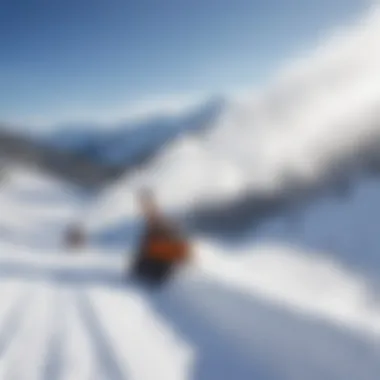The Science Behind Artificial Snow Production


Intro
Artificial snow, often seen in winter sports like skiing and snowboarding, is more than just frozen water. It involves a complex mixture of scientific principles and engineering techniques. Understanding how this snow is made can inspire young minds to appreciate both nature and technology. By exploring the processes, we uncover the importance of conditions required for snow formation, methods used for snow production, and its diverse applications. This guide seeks to illuminate these points clearly and engagingly for young science enthusiasts.
Science Fun Facts
- Temperature Matters: The air temperature must be low enough for water droplets to freeze when they leave the snow-making machines.
- Crystal Shapes: Natural snowflakes have unique crystal shapes due to the conditions in which they formed. Artificial snow also has distinct shapes that affect ski performance.
- Water Source: Most artificial snow systems use water from nearby lakes or rivers. This is crucial for keeping the process efficient and eco-friendly.
The process of making artificial snow requires a careful balance of temperature, humidity, and water pressure.
Interesting Trivia and Facts
- The first artificial snow machines were created in the 1950s in New Jersey.
- It can take several hours for the snow to dry after being made, affecting snow quality.
Quirky Science Stories
In the 1980s, scientists experimented with using Coca-Cola to create artificial snow for marketing purposes. Although it wasn’t successful, the experiment became a fun story showcasing innovative thinking.
Amazing Science Records
Did you know the largest snow-making operation is located in Colorado? It produces millions of gallons of snow each season, attracting thousands of visitors annually.
Thought-Provoking Questions
- How does artificial snow impact the natural environment?
- What differences can you find between natural and artificial snow?
Discover the Wonders of Science
Exploring Various Scientific Concepts
Understanding the mechanics behind artificial snow involves physics and chemistry. A snow gun creates snow by filling the air with tiny water droplets that freeze when they mix with cold air.
Educational Videos and Animations
There are great resources available on platforms such as Britannica and YouTube that explain how artificial snow is produced with visual aids. These can help reinforce learning.
Real-Life Applications of Science
Artificial snow plays a crucial role not just in sports but also in movie production, where it is used to create winter scenes, enhancing both realism and viewer experience.
Science Experiment Showcase
Fun and Engaging Experiments
You can try creating your own snow at home!
Materials List
- 1 cup of baking soda
- 1/2 cup of shaving cream
- A mixing bowl
Step-by-Step Instructions
- In the bowl, mix the baking soda and shaving cream together.
- Stir until it reaches a fluffy consistency, resembling snow.
- Play with it, and explore its texture and temperature differences.
Safety Tips and Precautions
Make sure to conduct this experiment in a controlled environment. If allergies to shaving cream exist, please avoid using it and seek an alternative recipe.
Epilogue
The process of making artificial snow combines intricate science and creative technology. By understanding these techniques and facts, young enthusiasts can gain a deeper appreciation of nature's wonders and human innovation. This knowledge not only enriches their learning experience but also encourages critical thinking about the world around them.


Foreword to Snow Formation
The formation of snow plays a vital role in Earth's climate and ecosystems. Understanding this process offers insights not only into weather patterns but also the broader environmental impacts that snow has on our world. In this section, we will explore the basic concepts of snow formation. This includes why snow is essential for natural landscapes, skiing, and other winter sports, as well as its influence on agriculture and water supply in various regions.
What is Snow?
Snow is a form of precipitation. It occurs when water vapor in the atmosphere freezes and crystallizes into ice particles. These ice crystals cluster together, forming snowflakes. Each snowflake is unique, with intricate designs shaped by the atmospheric conditions in which they form. Snow typically falls when temperatures are at or below the freezing point of water (0 degrees Celsius or 32 degrees Fahrenheit). In this way, snow can be seen as a fundamental part of Earth's water cycle, contributing to fresh water reserves as it melts in spring.
The Science Behind Snowflakes
The science of snowflakes is fascinating. When water vapor freezes, it forms hexagonal crystals due to the molecular structure of ice. The temperature and humidity level at the time of formation determine the size and shape of the snowflakes.
Some key points about snowflake formation include:
- Temperature: Flakes tend to be smaller in lower temperatures and larger in slightly warmer conditions.
- Humidity: Higher humidity can lead to more complex snowflake structures.
- Shape Variation: Different patterns arise based on where the flakes travel before reaching the ground.
The complex nature of snowflakes has led to extensive study. Researchers even describe snowflakes' shapes, giving them different names based on their appearance like "dendrites" or "columns".
Snowflakes, formed in unique conditions, reflect the beautiful complexity of nature and its processes.
Natural Versus Artificial Snow
Understanding the difference between natural and artificial snow is crucial in comprehending the broader context of snow formation. Natural snow occurs through environmental processes, whereas artificial snow is produced through human intervention. Discussing these two types allows us to explore their unique characteristics, benefits, and challenges.
Natural snow is formed in the atmosphere as water vapor cools and crystallizes into snowflakes. This process relies heavily on the right temperature, humidity, and atmospheric pressure. It contributes significantly to ecosystems, water supply, and recreational activities. However, reliance on natural snowfall can be inconsistent due to climate change and variable weather patterns.
On the other hand, artificial snow is created through snowmaking machines, which mix water and compressed air. This method is vital for ski resorts and other winter sports facilities, ensuring consistent snow coverage. Artificial snow can enhance the recreational experience but raises concerns about water usage and environmental impact. Striking a balance between these two forms of snow enhances understanding of their significance.
Defining Natural Snow
Natural snow forms when certain meteorological conditions are met.
- Process: It starts when moisture in the air freezes and falls as snowflakes.
- Formation Conditions: The temperature typically must be below freezing, allowing the water vapor to condense.
- Characteristics: Natural snowflakes are intricate and unique, shaped by their micro-environment as they fall through different temperatures, making each snowflake distinct.
Natural snow plays a vital role in earth’s ecosystems. It insulates the ground beneath, controls water flow into rivers, and supports winter sports activities.
Understanding Artificial Snow
Artificial snow is produced using specialized equipment designed to replicate natural snow conditions.
- Snowmaking Machines: These machines create artificial snow by spraying a mist of water droplets into cold air.
- Water and Air: A combination of water and compressed air is essential for producing snow. These droplets freeze rapidly as they hit the cold air.
- Chemical Processes: Some snowmakers use additives to enhance the snow performance, but this practice can spark debate concerning environmental implications.
Artificial snow allows ski resorts to maintain operations, especially in warmer periods where natural snow may be scarce. However, it requires substantial water resources and can hurt local environments if not managed properly. Understanding both types of snow helps us appreciate the delicate balance of nature and human influence.
Conditions for Snow Formation
Understanding the conditions for snow formation is vital when exploring the process of making snow. It identifies key environmental factors that contribute to snowfall, whether natural or artificial. Snow does not simply appear; it is the result of specific atmospheric conditions. These requirements set a foundation for further exploration into the techniques for creating artificial snow, impacting recreational activities, environmental considerations, and technological advancements.
Temperature Requirements
Temperature is a critical element in snow formation. For snow to form, temperatures need to be at or below the freezing point of water, which is 0 degrees Celsius or 32 degrees Fahrenheit. When the atmosphere cools sufficiently, water vapor condenses and crystallizes into snowflakes.
In practical terms, ski resorts and snowmaking facilities often aim to create snow when temperatures drop to around -2 to -5 degrees Celsius. This range allows for optimal snow quality. If temperatures are too warm, the water vapor may not freeze properly, resulting in slush or rain instead of snow. Thus, monitoring temperature is a necessary practice in snow production.
Humidity Influence
Humidity plays a significant role in the snow formation process. It refers to the amount of water vapor present in the air. The right humidity level enhances the likelihood of snowflakes forming and falling. Generally, relative humidity above 50% is preferable for snow to develop.
When humidity is low, even if temperatures are suitable, snow formation may be limited. This is because there isn’t enough moisture in the air to condense into large quantities of snow. In snowmaking, ensuring that humidity levels are adequate is essential. For this reason, artificial snowmaking systems often incorporate humidity as a factor in calculating snow production efficiency.
Air Pressure Role
Air pressure is another important factor in snow formation, albeit less discussed. Lower atmospheric pressure can lead to the expansion of air, which cools it down, contributing to snow formation. Additionally, changes in air pressure can create weather systems conducive to precipitation.


In regions where heavy snow typically falls, a pattern of low-pressure systems often brings the necessary conditions for snowfall. Understanding how air pressure interacts with temperature and humidity is crucial for predicting snowfall and is examined closely in meteorological studies.
"Conditions for snow formation are not merely academic; they determine how, when, and where we can enjoy activities on snow-covered landscapes."
Recognizing these conditions aids not only in understanding natural snowfall but is also essential for effective artificial snow production. The interplay of temperature, humidity, and air pressure establishes a baseline that informs snowmaking techniques and technologies used in various applications.
Techniques for Making Artificial Snow
Artificial snow has become crucial in environments where natural snowfall is insufficient for activities like skiing. Understanding the techniques of making artificial snow not only illustrates the scientific principles of snow production but also informs recreational and environmental practices. Various technologies and methods exist, each with specific benefits and challenges. By exploring these techniques, we can appreciate how artificial snow enhances winter sports and other applications while also considering environmental impacts.
Snowmaking Machines
Snowmaking machines are at the heart of artificial snow production. These machines use a process that combines water and air to create snow. The machine sprays tiny water droplets into the cold air. When the temperatures are low enough, the water droplets freeze before they hit the ground, forming snowflakes.
This technology is essential for ski resorts, especially in warmer regions. The machines allow resorts to create a dependable snow cover, which is vital for maintaining the ski season. They can produce snow even when natural snowfall is lacking. Some machines are mobile, enabling flexibility in where snow is created. However, the energy required to operate these machines can be considerable, leading to discussions about sustainability in snowmaking.
Water and Air Combination
The combination of water and air is a fundamental aspect of achieving artificial snow. Water is typically drawn from nearby lakes or rivers. It is then converted into fine droplets through various nozzles in the snowmaking machines. The air, which is essential for the freezing process, can come from compressors that deliver it at high pressure.
This combination needs precise monitoring. The temperature must be low enough, usually below -2 degrees Celsius, for the water to freeze as it is released into the air. The ratio of air to water can also affect the type of snow produced. More air creates lighter, fluffier snow, while less air results in heavier snowflakes. Understanding this balance can enhance the quality and usability of the snow generated.
Chemical Processes in Snow Production
In addition to mechanical methods, some techniques involve chemical processes to aid snow production. Certain chemical compounds can lower the freezing point of water, allowing it to turn to snow more easily under less ideal conditions. For instance, compounds like ammonium sulfate can promote ice crystal formation in warmer conditions.
However, the use of chemicals raises important environmental considerations. The impact on local ecosystems must be assessed. Some chemicals can be harmful to plants and animals in the surrounding areas if utilized excessively. Therefore, any chemical usage must be approached with care and ideally be subject to regulation. Understanding these chemical processes is essential for creating snow that does not compromise the ecological integrity of the areas affected.
"The evolution of snowmaking technologies reflects the need for adaptation in our changing environment, highlighting the intricate balance of recreation and nature."
Each of these techniques contributes to a comprehensive understanding of how artificial snow is created and deployed in various contexts. By analyzing the two fundamental elements of snowmaking, the machines employed and the processes involved, we gain valuable insights into the future of artificial snow production.
Environmental Considerations
Understanding the environmental considerations associated with artificial snowmaking is crucial. The process of creating synthetic snow involves not just the benefits of recreational activities but also impacts on natural ecosystems. As climate change alters weather patterns, the relevance of sustainable snow production becomes increasingly important.
Impact on Ecosystems
Artificial snow can significantly influence local ecosystems. While it enables ski resorts to function during less snowy winters, it may disrupt the natural habitats of various species. The water used in snowmaking often comes from local rivers, lakes, or groundwater sources. This can lead to a reduction in water levels, which is detrimental for aquatic life. Moreover, chemicals sometimes utilized in the snowmaking process can affect soil and water quality, posing risks to the flora and fauna in the vicinity.
The division of natural and artificial habitats can lead to changes in wildlife behavior. Species that rely on natural snowfall for their habitats may struggle as patterns shift. For instance, small mammals and migratory birds may find their food sources or nesting areas disrupted. Thus, understanding the ramifications helps inform better practices in snow production that minimize environmental harm.
Sustainability of Snowmaking
The sustainability of artificial snow production involves considering how operations balance recreational demands with environmental health. Snowmaking itself requires substantial resources, primarily water and energy. Hence, developing eco-friendly techniques is essential.
Some operators are now exploring methods to improve sustainability, such as:
- Using renewable energy sources: By substituting fossil fuels with solar or wind energy, resorts can significantly reduce their carbon footprint.
- Recycling water: Efficient recycling systems can lessen the dependency on local water resources. This not only preserves the ecosystem but also ensures a more stable water supply for future snowmaking.
- Innovative technologies: Advances in snowmaking technology, including improved snow guns, can reduce the amount of water and energy needed.
"Snowmaking is a necessity for many, yet it must be handled with care to protect our ecosystems."
In summary, the environmental considerations of artificial snowmaking are multi-faceted. They highlight the need for a balance between creating enjoyable winter sports experiences and preserving our natural environments for future generations.
Applications of Artificial Snow
Artificial snow goes beyond merely allowing ski enthusiasts to enjoy their favorite sport. The creation and usage of synthetic snow play a significant role in various sectors. Here, we will unpack the multiple applications of artificial snow and highlight its value and adaptability in different domains.
Ski Resorts and Recreation
Ski resorts typically rely on artificial snow to provide consistent and enjoyable skiing conditions. Natural snowfall can be unpredictable, leading to fluctuating winter seasons. By employing snowmaking technologies, resorts can ensure a steady supply of skiable terrain, extending their operational seasons.


Key benefits include:
- Improved Ski Conditions: Artificial snow can support a better skiing experience, as it can be produced in specific textures and densities to suit various activities, such as skiing or snowboarding.
- Increased Visitors: More reliable snow coverage encourages tourists, which can significantly bolster local economies.
- Event Management: Ski events, competitions, and tournaments can be organized with greater confidence in conditions, leading to well-attended and successful gatherings.
Artificial snowmaking systems, such as snow guns, efficiently utilize water and compressed air to produce snowflakes in varying conditions, ensuring that even low-temperature periods can provide the necessary snow textures.
Film and Event Production
Another essential application of artificial snow lies in the film and event production industries. Snow scenes often elevate the visual impact of movies and set the mood for special events. However, relying solely on natural snow can be risky and inconsistent.
Benefits include:
- Controlled Environments: Producers can create specific winter scenes in studios or locations not ideal for natural snowfall. This control dramatically reduces uncertainties, allowing greater creative freedoms.
- Safety Considerations: Artificial snow can be tailored to minimize safety risks by controlling density and quantity, thus avoiding potential hazards involved with excessive natural snowfall.
- Predictable Timelines: Having the ability to generate snow on-demand allows producers to meet tight schedules and timelines without extreme dependence on weather conditions.
Many films have relied on synthetic snow creation to capture enchanting winter moments. This practice only highlights the adaptability of artificial snow in enhancing storytelling and presentation.
Scientific Research
The realm of scientific research also benefits from artificial snow, particularly in understanding climate change, ecosystems, and hydrology. Institutions often use controlled snow environments for various experiments.
Some crucial aspects include:
- Climate Studies: Researchers study how artificial snow interacts with different environmental factors. This knowledge helps assess snow’s role in the climate system.
- Ecosystem Impact: Analysis of snow's effect on local flora and fauna allows scientists to gain insights into how changes in snow cover influence ecosystems.
- Water Resources: Understanding the dynamics between artificial snow and water runoff can inform water management strategies and practices, crucial for communities that depend on snowmelt for freshwater supply.
Overall, artificial snow is not just an engineering marvel. Its diverse applications make it a valuable tool across various fields, enhancing recreation, creativity, and scientific understanding. As technology evolves, one can only anticipate the further implications and contributions of artificial snow in our modern world.
The Future of Snowmaking Technology
The development of snowmaking technology holds significant implications for various industries, particularly in recreation and environmental management. As climates change and natural snow becomes less reliable, innovations in snow production will become increasingly vital. The expansion of artificial snowmaking technology will help ensure that ski resorts maintain appeal while also addressing environmental concerns.
Innovations in Equipment
New equipment is essential to the future of snowmaking. Recent innovations focus on improving the efficiency of snow production processes while reducing energy consumption and water usage. For instance, modern snow guns are designed to create finer snow particles, providing better coverage and a more natural feel.
These innovations come with several potential benefits:
- Energy Efficiency: New machinery uses less energy, decreasing operational costs.
- Water Conservation: Advanced systems allow for better management of water resources.
- Higher Quality Snow: The technology produces snow that is more resilient and can withstand varying weather conditions.
As companies prioritize the sustainability of their practices, it’s expected that innovative equipment will play a crucial role in future operations. Keeping abreast of industry advancements allows resorts to maintain competitive advantages and provide enjoyable experiences for visitors.
Research into Alternative Materials
Alongside better equipment, research into alternative materials can enhance snowmaking practices. Scientists are exploring new compounds that mimic snow's properties to develop more sustainable snow options. One intriguing area of study focuses on biodegradable substances that can be used in snowmaking.
Benefits of researching alternative materials include:
- Environmental Safety: Reducing the ecological footprint of snow production can help preserve local ecosystems.
- Cost-Effectiveness: Developing synthetic options could reduce operational expenditures in the long term.
- Expanding Applicability: New materials can illustrate potential uses beyond ski resorts, such as in leisure parks or events.
"Innovations and research into alternative materials will redefine how we approach artificial snowmaking, prioritizing sustainability while enhancing the quality of recreational experiences."
Understanding these developments prepares stakeholders for the future landscape of snow production. Emphasizing innovative solutions can ensure that both natural and artificial snow coexist benefit from scientific advancements.
Epilogue
Next, highlighting the differences between natural and artificial snow gives us insights into their implications for ecosystems and recreation. Significant environmental considerations arise from artificial snow production. It is essential for future practices to balance human enjoyment with ecological health.
Summary of Key Points
In summary:
- The formation of snow relies on specific atmospheric conditions, including temperature, humidity, and air pressure.
- Artificial snowmaking techniques involve the use of snowmaking machines, which create snow by merging water and air, with some processes using chemicals to enhance production.
- Understanding the environmental impact and sustainability of snowmaking is crucial as it affects ecosystems.
- Artificial snow finds diverse applications, from recreational activities in ski resorts to special effects in film production.
"The science of snowmaking reflects human ingenuity in adapting nature's processes for recreation and research."
Future Directions for Snow Research
Looking ahead, future research in snowmaking will likely explore various promising areas:
- Innovations in equipment: Researchers are interested in creating more efficient and less environmentally harmful snowmaking machines. Enhancements may include optimizing energy use and sourcing materials that minimize ecological disruption.
- Alternative materials: There is significant potential for exploring biodegradable materials in artificial snow production. This research may help in reducing the ecological footprint associated with traditional snowmaking methods.
- Weather pattern studies: Investigating changing weather patterns assists in adapting snowmaking techniques effectively. Weather fluctuations can inform how best to produce snow in varying climates.







